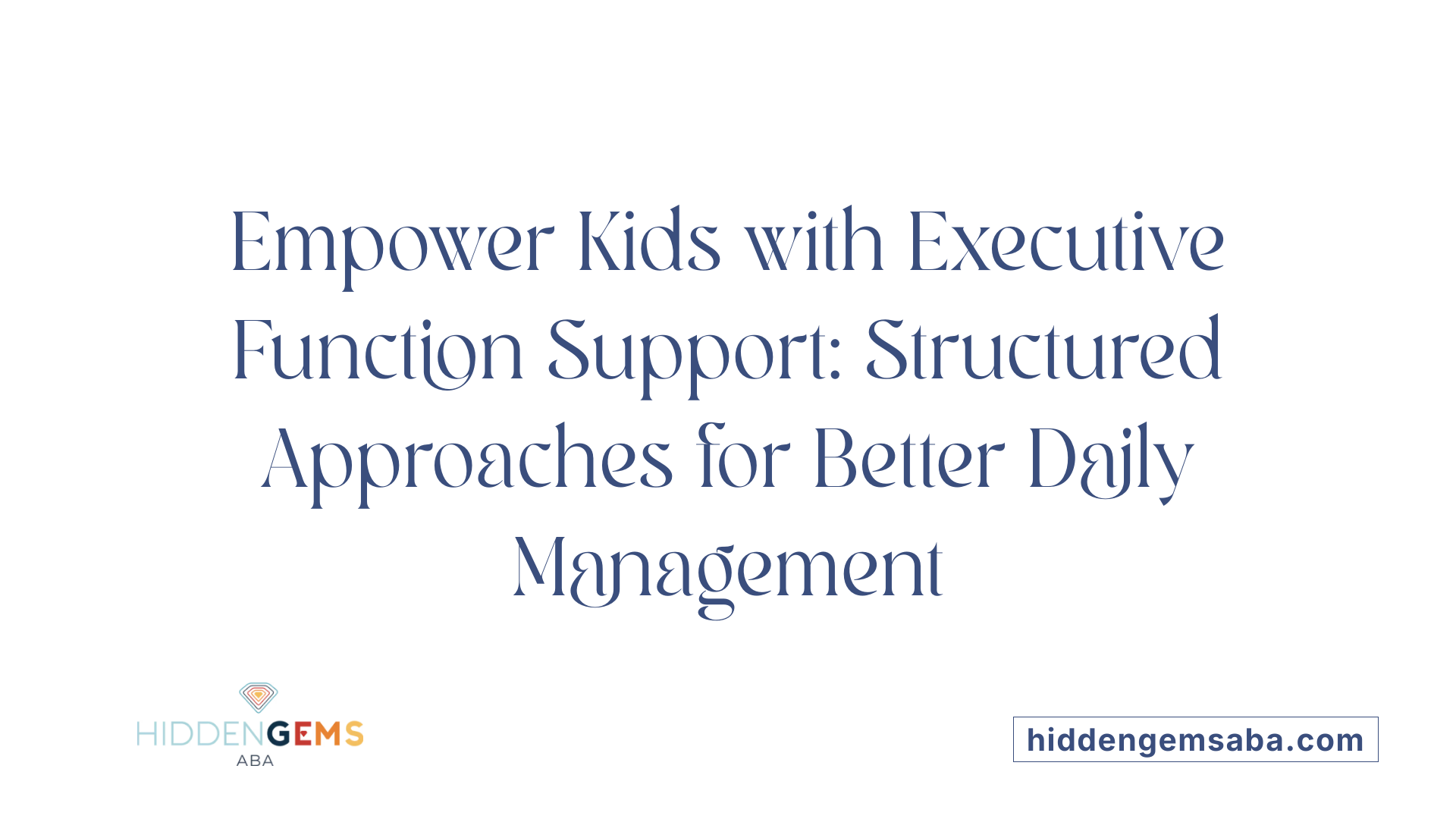Understanding Executive Functioning and Its Impact on Children with Autism
Executive functioning skills are essential cognitive processes that enable children to manage their daily activities, organize, plan, and regulate emotions. For children with autism and other developmental conditions, challenges in these areas can significantly affect their academic performance, social interactions, and independence. Research indicates that executive dysfunction accounts for over half of the variability in autism symptoms, emphasizing the importance of targeted interventions. Supporting these children involves tailored strategies like visual supports, routines, and environmental adjustments to foster better self-regulation and adaptive skills, ultimately helping them navigate the complexities of daily life.
Targeted Strategies to Develop Executive Skills

What are executive functioning skills and why are they important for children with autism and other developmental conditions?
Executive functioning skills consist of cognitive processes that enable children to organize, plan, and regulate their behavior effectively. These skills include working memory, flexible thinking, impulse control, and emotional regulation. They play a vital role in everyday tasks such as completing homework, managing social interactions, and adapting to new situations.
Children with autism often face challenges in developing these skills. Difficulties may involve trouble remembering instructions, shifting between tasks, or controlling impulses. These issues can lead to disorganization, frustration, and struggles with social cues and problem-solving.
Research shows that up to 80% of individuals with autism are affected by executive function disorder, which impacts their social, emotional, and academic success. To support these children, targeted interventions are crucial. Strategies like visual aids, checklists, routines, and modifications to their environment can significantly enhance their ability to self-regulate and succeed in daily activities.
How does ABA therapy specifically target and improve executive functioning skills?
Applied Behavior Analysis (ABA) therapy helps improve executive skills through structured, evidence-based methods. One fundamental technique is task analysis, where complex activities are broken down into smaller, manageable steps. Therapists use chaining, sequencing, and prompting to teach children how to follow multi-step instructions and complete daily routines.
Visual supports like visual schedules, checklists, and timers are incorporated to boost organization and time management. Reinforcement systems motivate children to practice and maintain these skills, gradually reducing prompts to foster independence.
ABA therapy also employs exercises to enhance flexibility, impulse control, and working memory. For example, children might engage in problem-solving tasks or activities that require shifting strategies, all while receiving positive reinforcement. Early, individualized programs ensure these skills generalize across settings—home, school, and community—maximizing their long-term impact.
In what ways can ABA therapy address challenges related to emotional regulation, sensory processing, and communication?
ABA therapy addresses emotional and sensory challenges by teaching children self-regulation strategies through visual aids and social stories. For emotional regulation, strategies such as self-talk and role-playing help children recognize their feelings and use coping skills like deep breathing or requesting a break. Reinforcement encourages consistent use of these strategies.
Sensory processing difficulties are managed through gradual desensitization and sensory-based routines. ABA programs may coordinate with occupational therapists to create sensory diets—customized activities that improve sensory tolerance. Environmental modifications, like calming zones or sensory tools, help children manage sensory overload.
Communication skills are also targeted. ABA employs modeling, prompting, and reinforcement to teach functional language and social interaction skills. These strategies facilitate better understanding, expression, and social engagement, supporting overall emotional and sensory well-being.
What research evidence supports the effectiveness of ABA therapy in enhancing executive functioning skills?
A growing body of research demonstrates that ABA therapy effectively enhances executive functions in children with autism. Studies utilizing assessments like the BRIEF-2 have documented improvements in planning, flexibility, and self-regulation after targeted ABA interventions.
Research indicates that early intervention, involving visual schedules, self-monitoring, and explicit teaching of skills, can significantly reduce executive dysfunction. Programs that incorporate visual supports and behavioral strategies lead to better adaptive behaviors and increased independence.
Empirical data shows that children who participate in early, intensive ABA programs demonstrate gains in daily functioning and social skills, correlating with improved executive functioning. These findings affirm that structured, evidence-based ABA approaches are effective tools for fostering vital cognitive skills.
What are the overall benefits of ABA therapy for children with executive functioning challenges?
ABA therapy provides broad and impactful benefits for children facing executive functioning difficulties. First, it enhances their ability to plan, organize, and problem-solve, which directly impacts academic and daily life success.
Children become more capable of following routines and completing tasks independently thanks to visual supports and structured routines. This, in turn, boosts their confidence and reduces frustration.
Furthermore, ABA helps develop communication and social skills, enabling children to better navigate interactions and build relationships. It also fosters emotional regulation and reduces problematic behaviors through positive reinforcement.
Overall, ABA promotes independence, improves quality of life, and supports smoother transitions between activities and environments. Incorporating these strategies early can lead to better long-term outcomes, helping children reach their full potential in everyday life.
The Neuroplasticity Advantage: Early Intervention Matters

Why is early intervention important?
Early intervention in ABA therapy is essential because it taps into the brain’s remarkable capacity for change during childhood — a period known as neuroplasticity. When children with autism or executive functioning challenges receive support early, their brains are more receptive to forming new neural pathways. This heightened brain plasticity during early years allows for more effective development of skills such as planning, flexibility, and self-control.
Timely intervention can significantly improve a child's social skills, independence, and adaptive behaviors. These improvements are often more difficult to achieve if support is delayed, making early ABA therapy a pivotal step in fostering long-term success.
What are critical developmental periods?
Critical periods refer to specific windows during childhood when the brain is especially responsive to learning. During these phases, neural circuits related to cognition, language, and social interaction are highly adaptable.
During these sensitive times, intensive interventions like ABA therapy can most effectively influence neural development. For example, engaging children in structured routines, visual supports, and reinforcement during these windows helps solidify essential skills.
How does neuroplasticity benefit children receiving ABA therapy?
Neuroplasticity is the brain's ability to form and reorganize synaptic connections in response to learning or experience. For children, especially during the early years, this means that targeted interventions can lead to lasting improvements in cognitive functions.
ABA therapy leverages neuroplasticity by providing consistent, tailored activities that stimulate the brain's growth. Techniques like task analysis, visual supports such as schedules and checklists, and reinforcement strategies help strengthen neural pathways associated with executive functions — planning, problem-solving, and behavioral regulation.
Because of this, children undergoing early ABA intervention often show increased abilities to manage daily routines, follow multi-step instructions, and adapt to new situations.
What are the long-term effects of early ABA intervention?
The benefits of early ABA intervention extend well beyond childhood. By enhancing neuroplasticity and supporting key skill development during critical periods, children tend to experience:
- Improved social interactions
- Increased independence and self-management
- Better academic performance
- Stronger emotional regulation
- Greater confidence and social integration
Studies and research emphasize that children who begin ABA therapy early tend to have more positive outcomes, including smoother transitions through developmental stages and a higher quality of life.
How does this understanding influence the timing and implementation of ABA programs?
Awareness of neuroplasticity's role during childhood dramatically impacts how ABA programs are designed and when they are implemented. It underscores the urgency of early diagnosis and prompt intervention.
Early ABA programs are structured to precisely harness neuroplasticity by intensifying session frequency, customizing strategies to each child's developmental needs, and involving family members for consistent support.
This approach maximizes neural growth and skill acquisition, leading to better generalization of skills across different settings like home, school, and social environments. Consequently, health professionals and families are encouraged to advocate for early placement in ABA therapy, ensuring children gain the maximum benefit from this critical window of brain development.
| Aspect | Explanation | Impact of Early Intervention |
|---|---|---|
| Timing | Critical periods in early childhood | Maximizes neuroplasticity for better skill development |
| Strategies | Visual supports, structured routines, reinforcement | Exploits brain's heightened capacity to learn |
| Outcomes | Improved social skills, independence, executive functions | Leads to more lasting and meaningful improvements |
| Long-term benefits | Better academic, social, and emotional functioning | Supports lifelong adaptive skills |
By understanding the importance of early intervention and neuroplasticity, caregivers, clinicians, and policymakers can prioritize timely ABA therapy. Starting support during these optimal developmental windows ensures children have the best chance at reaching their full potential.
Holistic and Individualized Approaches in ABA Therapy

How does ABA therapy tailor interventions to meet individual needs, especially for children with executive functioning challenges?
ABA therapy crafts personalized strategies for each child through thorough assessments that pinpoint their unique strengths and hurdles, particularly in executive functions like planning, impulse control, and flexible thinking. Based on these evaluations, therapists develop tailored intervention plans that incorporate visual supports such as visual schedules and checklists, along with task analysis and prompting techniques to guide behavior.
Engagement with families plays a crucial role. Regular data collection and progress tracking enable therapists to monitor a child's responses and adjust strategies accordingly, ensuring continuous improvement. This personalized method is also culturally sensitive and developmentally appropriate, maximizing relevance and effectiveness of the interventions.
Furthermore, family training equips caregivers with the skills and strategies needed to reinforce and generalize skills at home, providing consistency across environments. This comprehensive, individualized approach leverages evidence-based practices to foster meaningful and durable improvements in executive functioning.
What role do families play in supporting the development of executive functions through ABA?
Families are vital partners in the ABA process. They receive training on how to implement routines, utilize visual supports, and practice skills like time management and emotional regulation at home. This active involvement reinforces what children learn during therapy sessions, helping them apply skills across different settings.
Family participation in monitoring progress and providing positive reinforcement enhances skill acquisition. It also empowers caregivers to advocate for their child's needs and maintain a supportive environment. Engaged families help ensure the consistency necessary for skills to consolidate, promoting long-term success and independence.
How does ABA integrate with other therapeutic approaches to optimize outcomes?
ABA often works alongside speech and occupational therapies in a coordinated manner. Speech therapists may incorporate ABA techniques such as visual cues and reinforcement into language development, while occupational therapists address sensory processing and self-regulation in conjunction with behavioral strategies.
This synchronized approach ensures that interventions complement each other, creating a comprehensive support system that fosters overall development. For example, ABA's emphasis on structured routines and positive reinforcement can be integrated into occupational therapy to improve emotional regulation and sensory integration.
By collaborating across disciplines, therapists can address complex needs—such as social skills, emotional regulation, and sensory sensitivities—facilitating a child's progress toward independence and social integration.
What methods are used to track progress and ensure the effectiveness of ABA interventions?
Progress is closely monitored through systematic data collection during each session. Therapists record behaviors, skill acquisition milestones, and generalization across different settings via checklists, digital tools, and charts. Regular review meetings analyze this data to determine if goals are being achieved.
Adjustments to intervention strategies are made based on data insights, maintaining a dynamic and responsive therapy plan. Continuous assessments, parent feedback, and observable behavior changes provide a comprehensive view of progress.
This rigorous tracking ensures that ABA therapy remains targeted and effective, ultimately leading to improved independence, social skills, and emotional regulation for each child. By maintaining flexibility and responsiveness, therapy adapts to evolving needs, supporting successful outcomes.
Building a Foundation for Lifelong Success
ABA therapy plays a pivotal role in supporting children with executive functioning challenges by using evidence-based, tailored strategies that develop essential cognitive skills. Early intervention capitalizes on neuroplasticity, maximizing long-term benefits in independence, social skills, and emotional regulation. Through a holistic approach involving assessments, family training, and integration with other therapies, ABA fosters meaningful improvements that extend into academic performance, social interactions, and daily life. As research continues to affirm its effectiveness, ABA remains a cornerstone in helping children reach their full potential, laying a solid foundation for lifelong success.
References
- ABA Therapy and Executive Functioning: Building Skills for Success
- How ABA Therapy Supports Executive Functioning in Children with ...
- Tackling Challenges from Executive Functioning to Emotional ...
- How Therapy Supports Learning for Kids With ADHD & Executive ...
- Executive Functioning Challenges in Autism: Strategies for Parents
- ABA Therapy and Sensory Issues: Walking the Journey Together
- Teaching Emotional Regulation with ABA Tools
- ABA and School Readiness for Children with Sensory Processing ...
- Practical Strategies to Teach Emotional Regulation Skills in ABA ...






